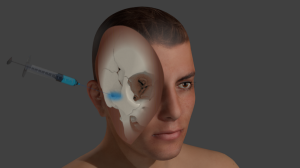What is a Sphenopalatine Ganglion Block?
Sphenopalatine Ganglion Block is an injection of a numbing medication through either one or both nostrils or the cheek using either a simple applicator or a needle. This numbing  medication on the ganglion offers relief of pain for facial pain, headaches and multiple head conditions and is performed on an outpatient basis. This procedure is very low risk and in most patients tolerated well.
medication on the ganglion offers relief of pain for facial pain, headaches and multiple head conditions and is performed on an outpatient basis. This procedure is very low risk and in most patients tolerated well.
It may be very helpful in patients who are experiencing headaches and facial pain due to an Arizona or Federal workmans compensation injury.
When Is the Procedure Indicated?
This procedure has been stated to be effective in relieving a wide assortment and types of headaches. This procedure can also help a patient experience virtually immediate pain relief. But, the older techniques used for the nerve block are very complicated, painful, and unreliable. So, the use of this method in the clinical setting has been under-utilized.
What exactly is the Sphenopalatine Ganglion?
The definition of a ganglion is a “mass of nerves” and as in this case, the shenopalatine  ganglion represents a “bundle of nerves” that spreads out of the lacimal gland, palate, paranasal sinuses, and through the entire upper nasal and pharynx cavity. This ganglion is located in a bony cavity that is referred to as the “pterygopalatine fossa” which is behind the nasal cavity and particularly deep in the midface.
ganglion represents a “bundle of nerves” that spreads out of the lacimal gland, palate, paranasal sinuses, and through the entire upper nasal and pharynx cavity. This ganglion is located in a bony cavity that is referred to as the “pterygopalatine fossa” which is behind the nasal cavity and particularly deep in the midface.
Since it has such a broad reach the nerves from the SPG expand the ganglion have an extremely major role in causing pain that is linked with acute and cluster headaches, TMJ, trigeminal neuralgia, facial pain, RSD, neck and head cancer, herpes zoster and much more.
How is the Procedure Performed?
There are numerous ways that Workers Compensation pain management physicians do an SPG block. The more common three methods are the transoral, transnasal, and latera  or through the cheek approach. The transnasal or through the nostril approach is the simplest method and the most common method among the three.
or through the cheek approach. The transnasal or through the nostril approach is the simplest method and the most common method among the three.
For the topical method of a SGB, the patient normally lies on her or his back with the neck extended and lidocaine gel is placed in the nostril. The patient then will “sniff” and the gel will anesthetize the entire nasal cavity. At that point, the Federal Workers Compensation pain doctor will quite gently insert a 10-cm cotton sterile tipped applicator immersed in numbing medication so it is touching the nasopharynx and hold it there for up to 30 minutes.
If the physician decides to do the SPG block by an injection, the cheek will already be numbed and the methodology can be made through soft tissues guided by a fluoroscopy or real time x-ray machine. When the needle reaches the area around the SPG, numbing  medication is injected. If this method gives exceptional pain relief, it may be reiterated every month or so, or the person can end up getting an “SPG radiofrequency ablation”.
medication is injected. If this method gives exceptional pain relief, it may be reiterated every month or so, or the person can end up getting an “SPG radiofrequency ablation”.
How well does a Sphenopalatine Nerve Block Work?
Numerous studies have reviewed the value of SPG blocks. On a consistent basis, it has shown to be an excellent method for acute and chronic head and facial pain. It has also been shown that “SPG radiofrequency ablation” has extremely high results that are satisfactory for individuals suffering with “cluster headaches”.
Addition studies have looked at these blocks for neck and head cancer pain, along with another study reviewing SPG for chronic vasomotor rhinitis. This showed that the injections work extremely well for both. The relief of pain was intense and patients needed much less narcotic prescription medicines. In addition to those conditions already mentioned there is new research frequently coming out showing the profits of SPG for the above- conditions.
What are the risks of an SPG block?
The dangers with “sphenopalatine ganglion nerve” are extremely low. With topical technique, the patients may endure a taste in the mouth that is bitter from the numbing agent having dripped down the propharynx. Injections retain a slight risk of infection along with a slight risk of nose bleeds or temporary lightheadedness.






Leave A Comment